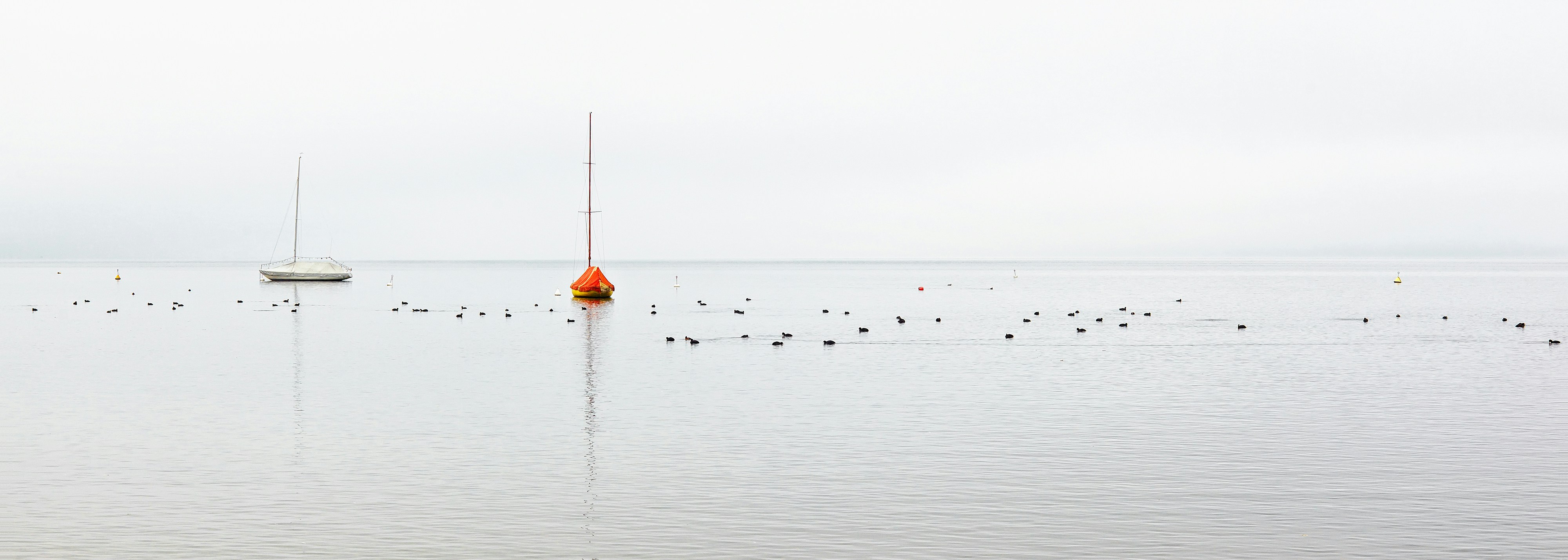Understanding Composition
Composition plays a vital role in creating compelling black and white photographs. By understanding the key elements of composition, you will be able to capture timeless monochrome images that leave a lasting impact.
Rule of Thirds
One of the fundamental composition techniques in black and white photography is the Rule of Thirds. This rule suggests dividing your frame into nine equal parts by drawing two vertical and two horizontal lines. By placing key elements along these lines or at their intersections, you create a sense of balance and harmony in your image.
Leading Lines
Another powerful composition technique is the use of leading lines. These lines draw the viewer’s eye into the photograph, guiding them towards the main subject. Look for natural or man-made lines such as roads, fences, or rivers, and position them strategically within your frame to add depth and visual interest to your monochrome images.
Symmetry and Patterns
Symmetry and patterns can add a sense of order and elegance to your black and white photographs. Look for symmetrical subjects or repetitive patterns in your surroundings. By placing them carefully within your frame, you can create visually captivating monochrome images that evoke a sense of balance and harmony.
By understanding and implementing these composition techniques in your black and white photography, you will be able to create striking and timeless monochrome images that convey a depth of emotion and captivate the viewer’s attention.
Mastering Light and Shadow
Mastering the art of black and white photography requires a deep understanding of light and shadow. By carefully manipulating these elements, you can create stunning monochrome images that stand the test of time. In this section, we will explore the importance of contrast, the significance of playing with highlights and shadows, as well as the benefits of utilizing natural light.
Importance of Contrast
One of the key factors that make black and white photography so captivating is the contrast between light and dark tones. To achieve this, you can experiment with different lighting setups, adjust exposure settings, or even enhance contrast during post-processing. By effectively managing contrast, you can add depth and visual interest to your images, creating a more dynamic and powerful composition.
Playing with Highlights and Shadows
In monochrome photography, highlights and shadows play a crucial role in defining the subject and creating a dramatic effect. Experiment with different lighting angles and intensities to cast interesting shadows and emphasize textures. Use shadows to add depth and mystery to your images, while highlights can draw attention to specific areas, creating a focal point.
Using Natural Light
Natural light has a unique quality that can produce striking black and white photos. Utilize the soft, diffused light during the golden hours, or experiment with the cast shadows during midday. Position your subject in a way that takes advantage of the available natural light to create a timeless and ethereal monochrome image.
By mastering the interplay between light and shadow, understanding the importance of contrast, and harnessing the power of natural light, you can create captivating and timeless black and white photographs. So grab your camera and start experimenting with these tips to take your monochrome photography to the next level!
This image is property of images.unsplash.com.
## Choosing the Right Subjects
When it comes to creating timeless monochrome images, selecting the right subjects is crucial. By focusing on certain types of subjects, you can enhance the visual impact and evoke a sense of nostalgia. Here are some categories to consider:
Architecture and Landscapes
Architecture and landscapes are ideal subjects for black and white photography. The intricate details, contrasting textures, and play of light and shadow can be beautifully captured in monochrome. Look for interesting structures, old buildings with character, and stunning natural landscapes to create impactful images.
Portraits and Candid Moments
Black and white portraits have a unique ability to capture the depth of emotions and tell a story. Focus on capturing expressions, emotions, and the true essence of your subject. Candid moments, such as people engaged in daily activities or caught unaware, can add a sense of authenticity to your images. Experiment with different lighting and composition techniques to create artistic and evocative portraits.
Still Life and Macro Photography
Still life and macro photography offer endless possibilities for creative black and white images. Everyday objects, flowers, or intricate details can become visually stunning when captured in monochrome. Pay attention to textures, patterns, and contrasts to bring out the beauty and intricacy of your subjects.
By choosing the right subjects for your black and white photography, you can create timeless and captivating monochrome images that leave a lasting impression.
Controlling Exposure
Capturing stunning black and white images requires a good understanding of exposure. This section will guide you through the essential tips and techniques to effectively control exposure and achieve timeless monochrome photographs.
Understanding Metering Modes
Metering is a crucial aspect of exposure control. You can choose between different metering modes, such as matrix metering, spot metering, and center-weighted metering, depending on your camera settings. Each mode measures the brightness of the scene differently, helping you determine the correct exposure settings.
Using Exposure Compensation
Sometimes, your camera’s metering system may not accurately determine the exposure for black and white photography. In such cases, utilizing exposure compensation is essential. Adjusting the exposure compensation allows you to make your images brighter or darker without affecting the metering mode, ensuring your monochrome photos have the desired tonality and contrast.
Bracketing for Dynamic Range
When dealing with high contrast scenes, bracketing becomes crucial. By taking a series of images at different exposure settings, you can capture all the details in both the highlights and shadows. This technique helps maintain a wide dynamic range, making your black and white images visually captivating and balanced.
Mastering exposure control is key to creating stunning black and white images that stand the test of time. By understanding metering modes, utilizing exposure compensation, and employing bracketing techniques, you can enhance the impact of your monochrome photographs.
Using Filters for Monochrome Photography
One of the key elements in capturing stunning black and white images is the use of filters. Filters are essential tools that can enhance your monochrome photographs, giving them a timeless and dramatic feel. By manipulating light and contrast, you can create powerful compositions that evoke a sense of nostalgia and depth.
Essential Filters for Black and White
When it comes to black and white photography, there are a few filters that every aspiring photographer should have in their kit. The first one is a polarizing filter, which helps reduce reflections and increase contrast, resulting in richer tones and sharper details. Another crucial filter is the red filter, known for its ability to darken blue skies and enhance the contrast between different shades of gray. Lastly, a yellow filter is perfect for adding warmth and softness to your images, especially when photographing landscapes or portraits.
Applying Graduated Neutral Density Filters
Graduated Neutral Density (ND) filters are particularly useful when shooting landscapes. These filters have a darkened portion that gradually transitions to a clear section. By placing the dark part over the bright areas of your scene, such as the sky, you can achieve a balanced exposure throughout the frame. This helps prevent overexposed highlights and underexposed shadows, resulting in a more even and harmonious composition.
Experimenting with Creative Filters
While using traditional filters is a great starting point, don’t be afraid to get creative and experiment with different types of filters. Infrared filters, for example, can give your black and white images a surreal and otherworldly look. Neutral density filters, on the other hand, allow you to capture long exposures and create ethereal effects like silky waterfalls or streaking clouds. Don’t be afraid to play around with different filters to discover your own unique style and bring a fresh perspective to your monochrome photography.
By using filters in your black and white photography, you can elevate your images to a whole new level. Experiment with different types of filters to achieve the desired effect and create timeless monochrome photographs that captivate viewers with their depth and emotion.
This image is property of images.unsplash.com.
## Post-Processing Techniques
Converting to Black and White in Adobe Lightroom
In the world of black and white photography, post-processing is an essential step in creating outstanding monochrome images. One popular software for post-processing is Adobe Lightroom, which offers a variety of tools and features to help you achieve the desired results. Converting your color images to black and white in Lightroom is a breeze. Simply navigate to the Develop module, locate the HSL/Color/B&W panel, and click on the “B&W” tab. Lightroom provides several presets to choose from, or you can manually adjust the sliders to fine-tune the conversion to your liking.
Adjusting Tones and Contrast
Once you’ve converted your image to black and white, it’s important to adjust the tones and contrast to enhance the overall composition. In Lightroom, you can use the Tone Curve panel to make precise adjustments. By manipulating the curve, you can darken or lighten specific areas of your image, creating a greater sense of depth and drama. Additionally, experimenting with the sliders in the Basic panel will allow you to fine-tune the brightness, contrast, highlights, shadows, and clarity of your black and white photograph.
Adding Vignettes and Grain
To add a touch of vintage charm and make your monochrome images look more timeless, consider adding vignettes and grain. Vignettes can be created by using the Effects panel in Lightroom. By adjusting the sliders, you can darken the edges of your image, drawing the viewer’s attention towards the subject. As for grain, Lightroom allows you to mimic the look of traditional film by adding realistic film grain effects. Experimenting with different amounts of grain can give your black and white photographs a unique aesthetic, reminiscent of classic film photography.
By mastering these post-processing techniques in Adobe Lightroom, you can take your black and white photography to the next level. Whether you’re a beginner or a seasoned photographer, exploring these tools will help you create stunning monochrome images that stand the test of time. Happy shooting!
This image is property of images.unsplash.com.
## Creating Dramatic Effects
Black and white photography has the power to create dramatic effects that can truly bring your images to life. By removing the distraction of color, you can focus on the core elements of composition, light, and texture, resulting in timeless and impactful monochrome images.
Long Exposure Photography
Long exposure photography is a technique that captures the passage of time in a single frame. By using a slow shutter speed, you can create stunning effects such as silky smooth waterfalls, streaking clouds, and ghostly figures. This technique is perfect for emphasizing movement and adding a sense of mystery to your black and white images.
High Contrast Silhouettes
Silhouettes offer a striking and powerful way to compose your black and white images. By placing your subject against a bright background, you can create a bold contrast that adds depth and drama to your photograph. Experimenting with different angles and shapes can lead to captivating and visually striking results.
Infrared Black and White
Infrared black and white photography opens up a whole new world of possibilities. By using an infrared filter or converted camera, you can capture an otherworldly and ethereal look. This technique allows you to play with the unique way infrared light interacts with the environment, resulting in hauntingly beautiful landscapes and portraits.
By exploring these black and white photography tips and techniques, you can unleash your creativity and create timeless monochrome images that will leave a lasting impression. So grab your camera and start capturing the world in shades of gray for a truly captivating experience.
Exploring Different Film Types
When it comes to black and white photography, the choice of film can significantly impact the outcome of your images. By understanding different film characteristics and experimenting with film grain, you can create timeless monochrome images that truly stand out.
Choosing the Right Film for Monochrome
Not all films are created equal, and this holds particularly true for black and white photography. Different films offer various tonal ranges, contrast levels, and grain structures, allowing you to achieve different artistic effects. Some films provide fine and smooth grain, perfect for capturing highly detailed images, while others produce a more grainy and gritty look that adds character and depth to your photos. By experimenting with different films, you can discover the one that best suits your unique style and vision.
Understanding Film Characteristics
Each film has its own unique set of characteristics, including its sensitivity to light and the range of tones it can capture. Some films are more sensitive to light, allowing you to work in low-light situations or achieve a high dynamic range. Others have a wider tonal range, capturing a broader spectrum of greys, which is particularly important in black and white photography where subtleties of tone can make a significant difference in the final image. Knowing the characteristics of the film you are using will enable you to make informed decisions about exposure, development, and printing.
Experimenting with Film Grain
Film grain refers to the visible texture in a photograph caused by the chemical structure of the film. It can greatly influence the look and feel of your black and white images. Fine grain films give a smooth and polished appearance, while films with coarser grain can create a more dramatic and vintage effect. Additionally, experimenting with push processing, where film is intentionally overdeveloped, can increase grain size and add a gritty look to your photos. By understanding the different characteristics of various film grains and deliberately using different techniques, you can create unique visual experiences and add depth to your monochrome images.
Exploring different film types is an essential part of mastering the art of black and white photography. By choosing the right film for monochrome, understanding film characteristics, and experimenting with film grain, you can unleash your creativity and achieve stunning results that will stand the test of time.
Tips for Shooting with Film Cameras
Metering and Exposure Techniques
When shooting black and white photography with film cameras, it’s crucial to understand metering and exposure techniques. Start by familiarizing yourself with your camera’s built-in light meter and learn how to use it effectively. Properly metering your scene will help you achieve accurate exposure and ensure that the tonal range in your black and white images is well-balanced. Experiment with different metering modes, such as spot metering or center-weighted metering, to find the best method for your desired outcome.
Loading and Unloading Film
Handling film can be a delicate process, but with practice, you’ll become efficient at loading and unloading rolls of black and white film. Keep your film in a cool and dry environment to prevent damage. Begin by carefully feeding the film leader into the camera’s take-up spool, ensuring that it catches securely. Once you’ve finished shooting, rewind the film back into the cartridge using the camera’s rewind dial. Always handle the exposed film in a darkroom or light-tight changing bag to avoid unwanted light leaks.
Developing and Scanning Film
Developing and scanning your black and white film is an essential step in the post-processing workflow. Find a reliable film lab or set up your own darkroom to develop your film. Take your time to learn the developing process, using appropriate chemicals and following the instructions precisely to ensure optimal results. Once your film is developed, it needs to be scanned to create digital copies. Invest in a high-quality film scanner or outsource the scanning to a professional lab to preserve the fine details and tonal range of your monochrome images.
By following these tips, you will gain the knowledge and skills needed to create timeless black and white photographs with your film camera. So grab your camera, load some black and white film, and start capturing stunning monochrome images that evoke a sense of nostalgia and timelessness.
Finding Inspiration for Black and White Photography
When it comes to capturing stunning monochrome images, finding inspiration can be just as important as mastering the technical aspects of photography. Here are some tips to help you spark your creativity and create timeless black and white photographs.
Exploring the Works of Master Photographers
One way to gain inspiration is by studying the works of master photographers who have excelled in the art of black and white photography. Examining their compositions, lighting techniques, and use of shadows can provide valuable insights into creating visually captivating images. Take some time to research renowned photographers such as Ansel Adams, Henri Cartier-Bresson, and Dorothea Lange, and analyze their black and white photographs.
Studying Monochrome Artworks
In addition to exploring photographs, studying monochrome artworks from other artistic mediums, such as painting or sketching, can also be greatly beneficial. Take note of the way these artists manipulate tone, contrast, and texture to optimize their monochrome creations. By understanding the techniques utilized in different art forms, you can apply these concepts to enhance your black and white photography.
Joining Photography Communities
Lastly, connecting with fellow photography enthusiasts through online communities or local photography clubs can provide a wealth of inspiration. Sharing your work, receiving feedback, and engaging in discussions with like-minded individuals can help ignite new ideas and push you to grow as a photographer.
Remember, finding inspiration is an ongoing journey. Take the time to explore different artistic influences and surround yourself with a supportive community to continually inspire and improve your black and white photography skills.



